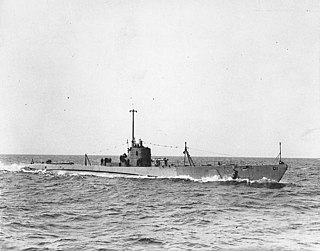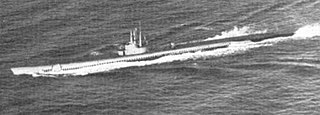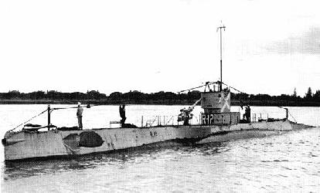
USS Dolphin (SF-10/SC-3/SS-169), a submarine and one of the "V-boats", was the sixth ship of the United States Navy to be named for that aquatic mammal. She also bore the name V-7 and the classifications SF-10 and SC-3 prior to her commissioning. She was launched on 6 March 1932 by the Portsmouth Navy Yard, sponsored by Mrs. E.D. Toland, and commissioned on 1 June 1932.

USS Argonaut (V-4/SF-7/SM-1/A-1/APS-1/SS-166) was a submarine of the United States Navy, the first boat to carry the name. Argonaut was laid down as V-4 on 1 May 1925 at Portsmouth Navy Yard. She was launched on 10 November 1927, sponsored by Mrs. Philip Mason Sears, the daughter of Rear Admiral William D. MacDougall, and commissioned on 2 April 1928. Although never officially designated as "SS-166", at some point she displayed this number on her conning tower.

USS Runner (SS/AGSS-476), a Tench-class submarine, was the second ship of the United States Navy to be named for the runner, an amberfish inhabiting subtropical waters.

USS Scorpion (SSN-589) was a Skipjack-class nuclear-powered submarine that served in the United States Navy, and the sixth vessel, and second submarine, of the U.S. Navy to carry that name.

USS R-12 (SS-89) was an R-class coastal and harbor defense submarine of the United States Navy.

USS Cochino (SS-345) was a Balao-class submarine in service with the United States Navy from 1945 to 1949. She sank after a battery explosion off Norway, on 26 August 1949. Cochino was named for the cochino, a triggerfish found in the Atlantic.

USS Cachalot (SC-4/SS-170), a United States Navy submarine and the lead ship of her class, known as the "V-boats", was the only ship of the United States Navy to be named for the sperm whale. Her keel was laid down by the Portsmouth Navy Yard. She was launched on 19 October 1933 as V-8 (SC-4) sponsored by Miss K. D. Kempff, and commissioned on 1 December 1933 with Lieutenant Commander Merril Comstock in command. Cachalot was the first submarine to have the Torpedo Data Computer, Arma Corporation's Mark 1, installed.

USS Cuttlefish (SC-5/SS-171), a Cachalot-class submarine and one of the "V-boats," was the second ship of the United States Navy to be named for the cuttlefish. Her keel was laid down by Electric Boat Company in Groton, Connecticut. She was launched on 21 November 1933 sponsored by Mrs. B. S. Bullard, and commissioned on 8 June 1934, Lieutenant Commander Charles W. "Gin" Styer in command. Cuttlefish was the first submarine built entirely at Electric Boat's facility in Groton, Connecticut; construction of previous Electric Boat designs had been subcontracted to other shipyards, notably Fore River Shipbuilding of Quincy, Massachusetts. Four Peruvian R-class submarines had previously been finished in Groton, using material from cancelled S-boats salvaged from Fore River.

USS Torsk, hull number SS-423, is a Tench-class submarine built for the United States Navy during World War II. Armed with ten torpedo tubes, the Tench-class submarines were incremental developments of the highly-successful Gato-class submarines that formed the backbone of the US Navy's submarine force during the war. Torsk was laid down at the Portsmouth Navy Yard in June 1944, was launched in September that year, and commissioned in December.

USS Bergall (SS-320), a Balao-class submarine in commission from 1944 to 1958, was the first ship of the United States Navy to be named for the bergall, a small fish of the New England coast. During World War II she made five war patrols between 8 September 1944 and 17 June 1945, operating in the South China Sea, Java Sea, and Lombok Strait and north of the Malay Barrier. During these patrols she sank two Japanese merchant ships totaling 14,710 gross register tons and one 740-displacement ton Imperial Japanese Navy frigate. She also damaged the Japanese heavy cruiser Myōkō, which was never repaired.
USS Corsair (SS-435), a Tench-class submarine, was the second ship of the United States Navy to be named for the California rockfish, or a pirate or privateer, especially Turkish or Saracen.

USS Tusk (SS-426), a Balao-class submarine, was the only ship of the United States Navy to be named for the tusk, an alternate name for the cusk, a large edible saltwater fish related to the cod. Her keel was laid down on 23 August 1943 at Philadelphia by the Cramp Shipbuilding Company. She was launched on 8 July 1945 sponsored by Mrs. Carolyn Park Mills, and commissioned on 11 April 1946.

USS Tigrone (SS/SSR/AGSS-419), a Tench-class submarine, was the only ship of the United States Navy to be named for the tigrone, a tiger shark found in tropical waters. Her keel was laid down on 8 May 1944 by the Portsmouth Navy Yard. She was launched on 20 July 1944 sponsored by Mrs. Mary B. Grisham, wife of Captain Charles F. Grisham, USN, Superintendent of the Portsmouth, N.H., Navy Yard, and commissioned on 25 October 1944.

USS Dragonet (SS-293), a Balao-class submarine, was a ship of the United States Navy named for the dragonet.

USS S-29 (SS-134), was a first-group S-class submarine of the United States Navy. During World War II, she also served in the Royal Navy as HMS P556.

USS S-50 (SS-161) was a fourth-group (S-48) S-class submarine of the United States Navy.

USS S-48 (SS-159) was the first submarine in the fourth group of S-class submarines of the United States Navy.

USS S-15 (SS-120) was a second-group S-class submarine of the United States Navy. Her keel was laid down on 13 December 1917 by the Lake Torpedo Boat Company in Bridgeport, Connecticut. She was launched on 8 March 1920 sponsored by Mrs. Simon Lake, and commissioned on 15 January 1921.
The Lake Torpedo Boat Company of Bridgeport, Connecticut, was an early builder of submarines for the United States Navy in the early 20th century.

USS Moody (DD-277) was a Clemson-class destroyer in the United States Navy in commission from 1919 to 1922 and from 1923 to 1930. She was named for Justice William Henry Moody.


















